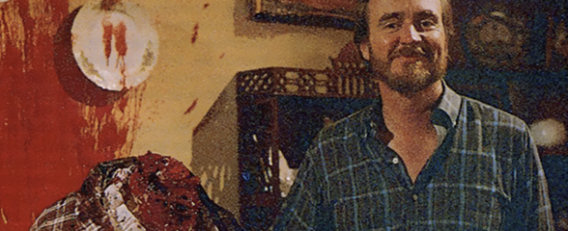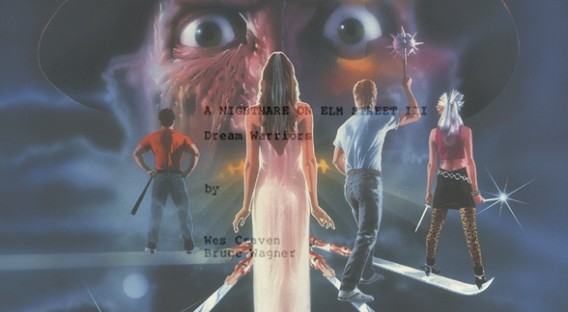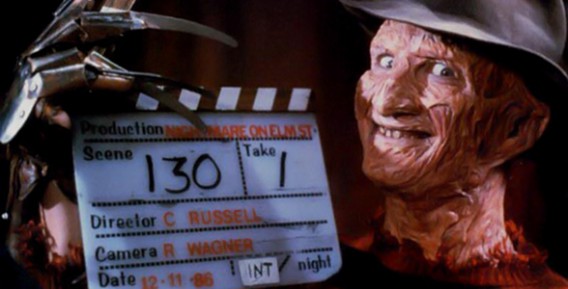
Although A Nightmare on Elm Street would become one of the most popular horror franchises of all time, even as production on the first movie came to an end during the summer of 1984, none of the principals involved had given any thought to the possibility of a sequel. Writer-director Wes Craven had forfeited his rights to the story and characters in order to finance the picture, whilst New Line Cinema had staked their entire company on the gamble that the movie would be a success. But as soon as the box office takings were counted, studio president Robert Shaye needed little convincing that a second film would be a sound investment. “I’ve been accused of fighting for movies that could have sequels but that wasn’t really the case. I just felt the ending to the movie didn’t send the audience out with any great excitement,” stated Shaye in the 2010 documentary Never Sleep Again: The Elm Street Legacy, regarding his decision to add a short epilogue that indicated the film’s antagonist, Freddy Krueger, had not been defeated.
With heroine Nancy Thompson (Heather Langenkamp) having lost all of her friends and mother to Freddy, she comes to the realization that it is her fear that has given him power over her. Turning her back on him, she takes away his strength and Freddy is once again banished to the dream world. “We were uncertain about the ending,” Shaye continued. “We didn’t really feel like we had it right. Wes wanted the ending to be that Heather woke up in the morning and the sun was shining and she walked away.” A Nightmare on Elm Street would become an unexpected success and transformed New Line from a struggling distribution company to a major Hollywood studio, whilst Craven would become inundated with offers for other pictures. Having been denied the chance to cast his influence over the sequel, A Nightmare on Elm Street Part 2: Freddy’s Revenge, Craven had been disappointed with the end result, feeling that it had violated many of the rules he had introduced in the first movie.
Yet, to Craven’s surprise, he would be contacted by the studio with the opportunity to develop a second sequel. Shaye had been disappointed with Freddy’s Revenge, feeling that it lacked the winning elements that had made Craven’s film such a success, and wanted to bring the filmmaker back to the series to develop what he hoped would be a more worthy follow-up. The first decision that Craven and Shaye would agree upon regarding the story was to bring back the characters of Nancy and her father, Donald (John Saxon). Whilst he had written the script for the original movie by himself, Craven had already committed to another project, Deadly Friend, and so turned to an up-and-coming writer, Bruce Wagner, for assistance. Wagner had grown up in Beverly Hills and had spent his youth dreaming of becoming an author, having obsessed over such writers as Henry Miller and eventually dropping out of high school to work in a book store.
Craven had been introduced to Wagner through a filmmaker called Paul Bartel (who would direct Wagner’s second script, Scenes from the Class Struggle in Beverly Hills) and, balancing several projects, asked the young writer to adapt his concept into a screenplay. “Bruce and I are writing together, talking through everything. He has actually been putting the stuff down on paper,” Craven told Fangoria in 1986. As well as Deadly Friend, Craven would be linked to several other pictures during this time, including Superman IV (released in 1987 as The Quest for Peace and directed by Sidney J. Furie) and, Wagner would reveal during an interview with Spike Magazine in 2002, Beetlejuice. “I’m contractually obliged to a pay-or-play deal on another film, Haunted, a love story about a guy, a girl and a ghost, for Heron Communications, whose parent company is Media Home Entertainment, one of the big funders of the Nightmare series,” said Craven. “If Haunted does fall through, I might well try to jump in at the last minute and direct Nightmare 3. But otherwise, it’s just being written by myself and Bruce Wagner.”

Craven and Wagner’s script would begin five years after the events of A Nightmare on Elm Street, in which Nancy’s father (renamed John for some unexplained reason, perhaps a confusion with actor John Saxon) has quit the police force and has been searching the country in an attempt to locate the birthplace of Freddy, thus uncovering the truth behind his monstrous legacy. Nancy has followed her father over five states but has always been one step behind. The opening sequence would see Freddy’s infamous claw tearing its way out of a pregnant stomach, before the camera pans back to reveal a derelict farmhouse… Freddy’s childhood home. After falling asleep behind the wheel and losing control of her car, Nancy wakes up in a field as a kind-hearted doctor, Neil Guiness, shines a light in her eyes. Concerned for the young woman, he offers for her to spend the night in his guest room whilst her car is fixed. Later that night, Neil discovers Nancy thrashing violently in her sleep and notices a bottle of pills by the side of the bed; an experimental dream suppressant called Hypnocil.
Accompanying Neil to his hospital the following morning, Nancy is introduced to a group of young patients who have all attempted to take their own lives after being plagued by a series of horrifying nightmares. The latest patient to arrive is Kirsten Parker, who has been admitted after slitting her wrists, but to Nancy’s horror the girl begins to sing a nursery rhyme that would remind her of Freddy Krueger. When Neil returns Nancy to her car the police are on the scene, having found the body of a young hitchhiker who Nancy had offered a lift to before falling asleep and crashing her car. Nancy looks over at the farmhouse nearby and recognizes it from one of her the nightmares. Neil informs her that he had been there himself a few weeks earlier when a man was apprehended trying to burn it down, as he claimed the house was ‘alive.’ Nancy insists on Neil showing him the patient, only to discover the so-called schizophrenic is her own father.
“We’re exploring not only dreams but other states of altered reality within the human consciousness and we’ll be trailing through all of them. Also, this house will be sort of an architectural portal to that world. It is virtually a limitless world of the human psyche in all its dimensions, many of which will be explored,” Craven told Fangoria in the same issue, whilst also revealing that his story ignores both the characters and events from Freddy’s Revenge. He would also introduce an important element from his script; a group of teenagers who would have the power to defeat Freddy in the dream world. “There will be a group of very special kids who will align themselves with Nancy and her father to fight Freddy. Freddy is about to pass on to a higher level of evil, greater powers, expanded effects on others. Freddy’s moving up. These people are the last stand against him before he gets so big that no one can stop him.” These children in question would come to be known as the ‘dream warriors,’ of which Kirsten would be the most powerful and the key to their strength.
With Craven obligated to deliver a first cut of Deadly Friend even whilst New Line were anticipating the script to A Nightmare on Elm Street 3, Wagner would take the basics of Craven’s story and adapt them into a screenplay, which would be notable for upping both the violence and brutality of Freddy. Submitting the script to New Line, Shaye and Sara Risher, who first joined the company during the mid-1970s when they were specializing in the distribution of cult and foreign movies, were intrigued by the concept but felt that it lacked the commercial appeal of the first film. Deciding that the script needed to be rewritten, Risher was approached by Rachel Talalay, who had climbed up the ranks of New Line and had been closely associated with the franchise (and would later make her directorial debut with 1991’s Freddy’s Dead: The Final Nightmare), regarding a pair of young writers she felt would be able to turn the story around and deliver a script that would be more suited to their needs. “We were in the process of rewriting that script with Wes when our producers at the time had met with some young, smart, up-and-coming writer-directors; Frank Darabont and Chuck Russell,” explained Risher when interviewed for Never Sleep Again: The Elm Street Legacy. “And they said, “Please hear their pitch. They have a great pitch; we think this is the best way to go.””

Both Frank Darabont and Chuck Russell had already gained experience within the horror genre prior to forming a writing partnership, that would also result in the enjoyable 1988 remake of The Blob. Darabont’s first foray into filmmaking came with a short film entitled The Woman in the Room, which was based on a Stephen King story and would prove to be the first of several adaptations that Darabont would make of King’s work (later followed by The Shawshank Redemption, The Green Mile and The Mist). Russell had relocated from Chicago to Los Angeles during the late 1970s and had made the acquaintance of exploitation filmmaker Tom DeSimone; working as a first assistant director on the 1977 sex comedy Chatterbox and as executive producer on the 1981 slasher Hell Night. In 1984, Russell turned to writing with the supernatural thriller Dreamscape, which would eventually bring him to the attention of Talalay. Determined to transform Craven’s concept into something more marketable, New Line hired Darabont and Russell to rework the original story.
“When we went into this we knew we couldn’t be scarier than number one. I was a huge fan of number one and this was my chance to direct and I dragged Frank into the situation,” said Russell during a screening of the movie in 2008 at the New Beverly Cinema in Hollywood, hosted by screenwriter Diablo (Juno) Cody. During the same interview Darabont added, “We had eleven days to… rewrite the script… and so we hopped in his (Russell) car and we drove up to Big Bear to this rented cabin, and we jumped in this rented cabin and for eleven days we’re writing like the bastard son of a hundred maniacs.” With less than two weeks to work, Russell would fall ill whilst staying at the cabin, with his temperature eventually reaching a hundred and four degrees, resulting in Darabont having to drive his friend to the nearest hospital. Despite the various setbacks, the script was delivered to New Line on time and Russell was finally given his chance to direct. There would be a lot of significant differences between Craven and Wagner’s draft and the version eventually submitted by Darabont and Russell. Whilst both would focus on a group of gifted youngsters, the latter drafts would see Nancy as an expert in dreams and newly recruited by a hospital that treats suicidal teenagers.
Other changes would include Neil Guiness, would be renamed Neil Gordon, whilst several of the younger characters would also change; in Wagner’s script Taryn is described as a ’15 year old black girl,’ but in the movie would be portrayed by twenty-six year old caucasian actress Jennifer Rubin. In the first draft it would be the character of Joey (later portrayed as a mute in the movie by Rodney Eastman) who would create the papier mache house, whilst in Darabont and Russell’s version it was Kirsten. Nancy’s father would also be changed for the film; no longer determined to destroy Freddy once and for all, he would be rewritten as bitter and drunk, having been demoted from police lieutenant to security guard. Some set pieces would be adapted by Darabont and Russell and used in a different manner; for example, in Craven and Wagner’s script, Neil’s bottom jaw dislocates and his mouth opens as he turns into some kind of demonic snake, dragging her feet between his teeth and attempting to devour her, whilst in the movie it would be Kirsten who is attacked by Freddy (misspelt Freddie in Craven and Wagner’s draft) in the form of a giant snake.
Yet despite the hype that surrounded the release of A Nightmare on Elm Street 3: The Dream Warriors, Craven began to express bitterness towards both the studio and writers. In an interview with Fangoria Craven claimed; “What they did was change a lot of names. They did change a lot of things that they felt were too expensive to attempt, and they added some things I felt were not as good.” Angered by his comments, Darabont submitted a letter to the magazine that was published several issues later stating; “With all due respect to Wes Craven, I must take exception to his comments about the Nightmare 3 rewrite (issue #62). If it were true that all Chuck Russell and I did was ‘change a lot of names,’ the Writer’s Guild arbitration would never have awarded us screen credit… It would never occur to me to belittle Wes Craven or Bruce Wagner’s contributions to Nightmare 3, which are inarguably substantial. I wish Mr. Craven would afford Chuck and me the same courtesy, even if he is feuding with New Line.” Risher would later join in the debate during an interview with Cinefantastique, in which she would comment that, “I don’t understand why he (Craven) doesn’t give credit where credit is due. Chuck Russell made the script (for Part III) work. I give Wes complete credit for the terrific idea of these kids – the dream warriors – I’m not faulting that. But Chuck Russell and Frank Darabont turned that script around… They rewrote 70 percent of it.”


6 Responses to Wes Craven’s Dream Warriors